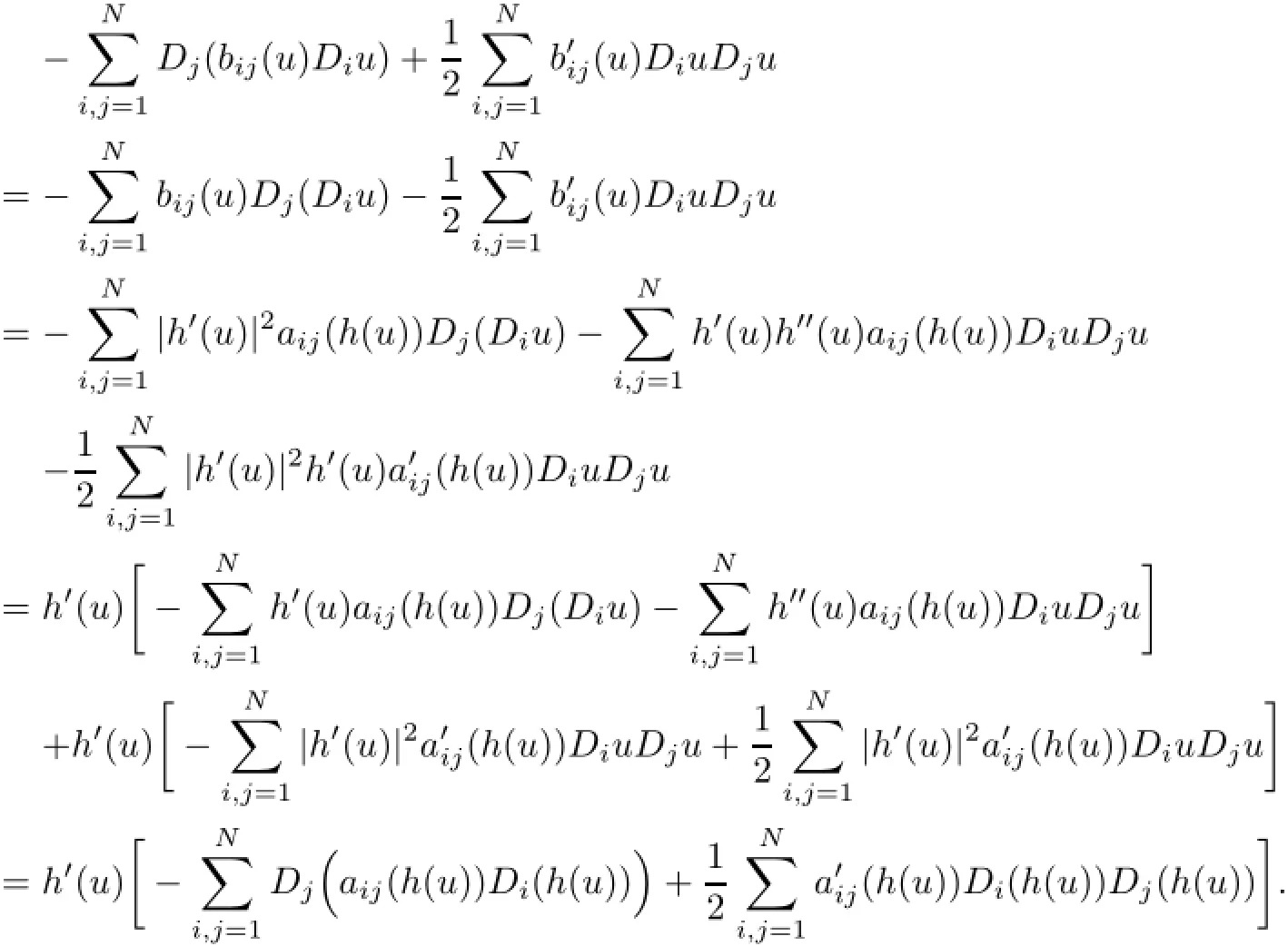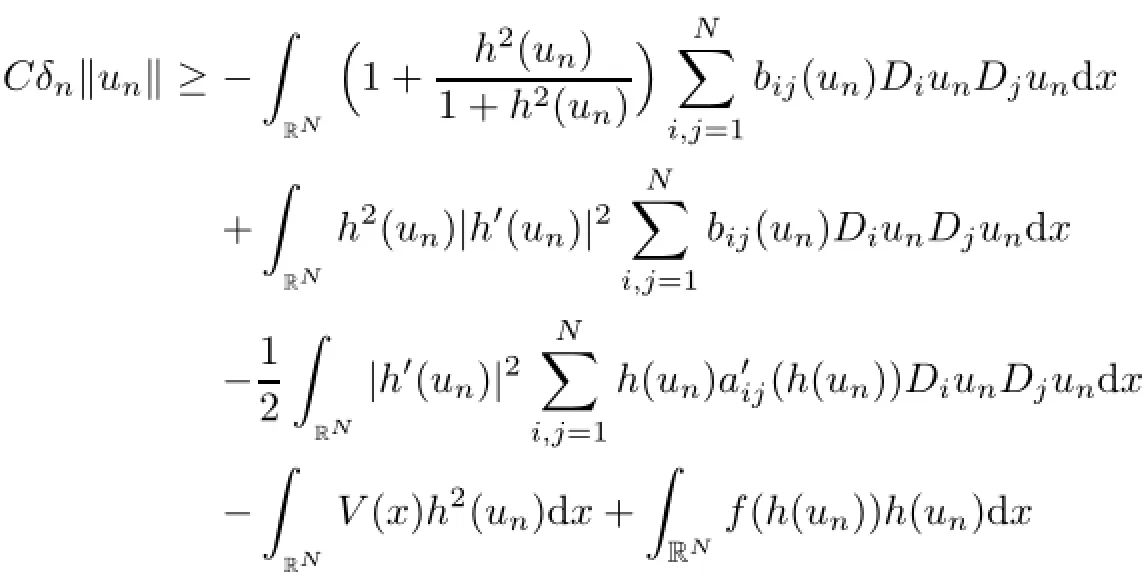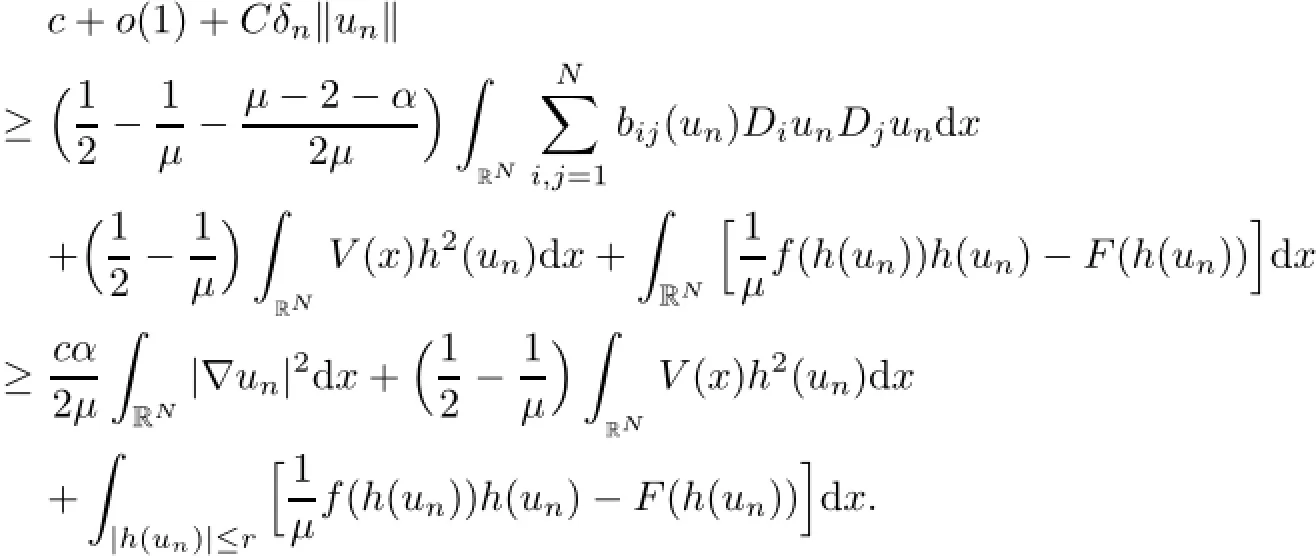MULTIPLICITY OF SOLUTIONS FOR A QUASILINEAR ELLIPTIC EQUATION∗
2016-09-26KeWU吴科XianWU吴鲜
Ke WU(吴科)Xian WU(吴鲜)
Department of Mathematics,Yunnan Normal University,Kunming,Yunnan 650500,China
E-mail∶wuke2002@126.com;wuxian2042@163.com
MULTIPLICITY OF SOLUTIONS FOR A QUASILINEAR ELLIPTIC EQUATION∗
Ke WU(吴科)Xian WU(吴鲜)
Department of Mathematics,Yunnan Normal University,Kunming,Yunnan 650500,China
E-mail∶wuke2002@126.com;wuxian2042@163.com
We study a quasilinear elliptic equation with polynomial growth coefficients.The existence of infinitely many solutions is obtained by a dual method and a nonsmooth critical point theory.
Quasilinear equation;dual method;critical point;nonsmooth analysis
2010 MR Subject Classification35J20;35J62;49J52
1 Introduction and Main Result
Consider the following quasilinear elliptic equation of the form


Indeed,equation(1.2)is the special case of(1.1)with aij(s)=(1+2s2)δij.This type of quasilinear equations appears in some models in mathematical physics(see[2,3,8]).
For the case in which some of coefficients aijin(1.1)are unbounded,the existence and multiplicity of solutions to(1.1)have been studied by several authors in recent years.For example,the existence of multibump solutions was obtained in[9,10]by using a cutoff technique and nonsmooth critical point theory.The Nehari method was applied to establish the existence of both one-sign and nodal ground states of solutions in[12].In[13,15],by considering a 4-Laplacian perturbation equation of(1.1),solutions of(1.1)were obtained as limits of solutions of the perturbation problem.
In form,(1.1)has a energy functionaldefined on the Hilbert space


In this article,we transform equation(1.1)to another with a continuous energy functional in some Banach space.Nonsmooth critical point theory then can be applied to obtain the existence of multiple solutions to the original problem.Though the main ideas used here are originally due to M.Colin,L.Jeanjean[5]and J.Liu,Y.Wang and Z.Q.Wang[11],we do not use them directly but make some crucial modifications and use some new techniques.
We are interested in the following cases.
(V)V is Hüolder continuous,V(x)>0,andV(x)=∞.
(f1)f is odd and Hüolder continuous.
(f2)There exist constants C>0,and 4<p<22∗such that

(f4)There exist constantsµ>4 and r>0 such that sf(s)−µF(s)>0 for|s|>r,where
(a1)aij∈C1,γ(R,R)for some 0<γ<1,aij=aji,aij(−s)=aij(s)and there exists a positive constant c0such that

for s∈R and ξ∈RN.
(a2)There exists a constant α>0 such that

for s∈R and ξ∈RN.
We can state our main result now.
Theorem 1.1If assumptions(V),(f1)−(f4),and(a1)−(a2)hold,then(1.1)has a sequenceof solutions such that
2 Dual Variational Framework

is well defined on

which is a Banach space with the norm

We have the following result with respect to the space E.The proof is almost the same as that of Proposition 2.1 in[6].
Proposition 2.1

In order to prove our main result,we need some further properties of the function h.
Lemma 2.2The function h has the following properties.

ProofBy direct integration,we getThen,the conclusions(1),(2),(3),and(5)follow.A proof of(4)can be found in[7].The proof is completed.
By applying Lemma 2.2,the following conditions hold under the assumptions(a1),(f2),and(f3).
(b1)and there exists a constant c>0 such thatand

(g1)|g(s)|≤C(1+|s|q−1)for all s∈R,where q=p/2;
Lemma 2.3Assume that the conditions(f2),(f3),and(a1)hold,then the functional I∈C(E,R)and the derivatives of I exist along directions of E∩L∝(RN),that is,

for every u∈E and ϕ∈E∩L∝(RN).Moreover,the functional u〈I′(u),ϕ〉is continuous for each ϕ∈E∩L∝(RN).
ProofLet{un}⊂E be a sequence such that un→u in E.By Proposition 2.1 in[11],we have

Moreover,up to a subsequence,un→u in Ls(RN)for 2≤s≤2∗,∇un→∇u in L2(RN),un(x)→u(x)and∇un(x)→∇u(x)a.e.x∈RN.Applying Lemma A.1 in[14],there exist g1∈L2(RN)∩Lq(RN)and g2∈L2(RN)such that|un(x)|≤g1(x)and|∇un(x)|≤g2(x)a.e. x∈RN.It then follows from(b1),(g1),(g2),and the Lebesgue theorem that

and

Thus,I(un)→I(u)and I is continuous in E.Similarly,It can be proved that the functional〈I′(·),ϕ〉is continuous in E for each ϕ∈E∩L∝(RN).The proof of(2.1)is standard by using conditions(b1),(g1),(g2),and the Lebesgue theorem.The proof is completed.
Theorem 2.4If u∈E∩C2(RN)satisfies〈I′(u),ϕ〉=0 for all ϕ∈E∩L∝(RN),then h(u)is a solution to(1.1).
ProofIt follows from the Lemma above that

for all ϕ∈E∩L∝(RN).A standard argument shows that u∈E is a solution to the following equation

By the definition of bij,we have

Therefore,by(2.2),we have

which implies that h(u)is a solution to(1.1).The proof is completed.
Remark 2.5Theorem 2.4 is a generalization of the result in pages 217-218 in[5].

The conclusion then follows.The proof is completed.
3 Nonsmooth Critical Framework
We begin by recalling some notions from nonsmooth critical point theory(see[1,4]).Next,we denote by(X,d)a metric space.
Definition 3.1Let f:X→R be a continuous function and let u∈X.We denote by|df|(u)the supremum of the σ's in[0,∞)such that there exist δ>0 and a continuous map H:B(u,δ)×[0,δ]→X satisfying d(H(v,t),v)≤t and f(H(v,t))≤f(v)−σt for all(v,t)∈B(u,δ)×[0,δ].The extended real number|df|(u)is called the weak slope of f at u.
Definition 3.2Let f:X→R be a continuous function.A point u∈X is called to be a critical point of f if|df|(u)=0.A real number c is called to be a critical value of f if there exists a u∈X such that f(u)=c and|df|(u)=0.
Definition 3.3Let f:X→R be a continuous function and let c∈R.We say that f satisfies the(PS)ccondition if each sequence{un}⊂X with f(un)→c and|df|(u)→0 has a convergent subsequence.
Theorem 3.4([1])Let E be an infinite-dimensional Banach space and let f:E→R be continuous,even and satisfying(PS)ccondition for every c∈R.Assume that
(i)there exist ρ>0,β>f(0)and a subspace V⊂E of finite codimension such that

(ii)for every finite-dimensional subspace W⊂E,there exists R>0 such that

Then,there exists a sequence{cn}of critical values of f with cn→∞as n→∞.
Now,consider the functional I given in the previous section.
Lemma 3.5|dI|(u)≥sup{〈I′(u),ϕ〉:ϕ∈E∩L∝(RN),‖ϕ‖=1}.
ProofWe employ a similar argument in the proof of Theorem 1.5 in[4].Let u∈E and Ψ(u)=sup{〈I′(u),ϕ〉:ϕ∈E∩L∝(RN),‖ϕ‖=1}.If Ψ(u)=0,the conclusion is trivial. Otherwise,take σ>0 such that Ψ(u)>σ.Then,there exists a point ϕ∈E∩L∝(RN)with‖ϕ‖=1 and〈I′(u),ϕ〉>σ.By Lemma 2.3,there exist δ0>0 such that〈I′(v),ϕ〉>σ for every v∈B(u,δ0).Let δ=δ0/2 and H(v,t)=v−tϕ.We see that H:B(u,δ)×[0,δ]→E is continuous,‖H(v,t)−v‖≤t,and

for(v,t)∈B(u,δ)×[0,δ].Hence,|dI|(u)≥σ and|dI|(u)≥Ψ(u)by the arbitrariness of σ. The proof is completed.
Lemma 3.6If u∈E satisfies〈I′(u),ϕ〉=0 for each ϕ∈E∩L∝(RN),then u∈L∝(RN).
ProofBy(2.1),we have


for all ϕ∈E∩L∝(RN).
For T>0,let uT=u for|u|≤T and uT=sign(u)T for|u|≥T.It then can be deduced from(3.1)and Lemma 2.6 that

for each r≥0.
Applying(a2),(b1),and Lemma 2.2(2),we have

where c1is a positive constant.
For any ε>0,it follows from(g1)and(g2)that there exists a C(ε)>0 such that

for each s∈R.This implies that for small ε,

where C and C1are positive constants.
we have

Taking T→∞,we obtain

Let r0=0 and 2d(rk+1+1)=2∗(rk+1).Then rk→∞and

Corollary 3.7If u∈E is a critical point of I,then u∈L∝(RN).
ProofThe conclusion follows easily by Lemma 3.5 and Lemma 3.6.The proof is completed.
Lemma 3.8The functional I satisfies(PS)ccondition for every c∈R.
ProofLet{un}⊂E be a sequence with I(un)→c and|dI|(un)→0.It then follows from Lemma 3.5 that

Moreover,

Let wn=h(un)/h′(un).From(3.6),Lemma 2.2(3),and Lemma 2.6,we have

for each n.
Consequently,by(a2),we conclude


As I(un)→c,by(b1)and(f4),we have

Using similar arguments as in page 1303 in[16],there exists a positive constant M such that

Thus,{un}is bounded in E.
Passing to a subsequence,∇un⇀∇u in L2(RN).By arguments as in Lemma 2.3 in[4],we conclude that〈I′(u),ϕ〉=0 for each ϕ∈E∩L∝(RN).Let w=h(u)/h′(u).It then follows from Lemma 2.2 and Lemma 3.6 that〈I′(u),w〉=0.Thus,

Note that δn→0 and{un}is bounded in E.From(3.7),we get

We conclude from Proposition 2.1(III)that Z

By assumptions(V),(b1)and(a2),and the Fatou Lemma,we have


and

These imply that

and

Moreover,by applying Proposition 2.1(II),the Lebesgue dominated convergence theorem,and the weak convergence of{un},we conclude that

which implies un→u in E.The proof is completed.
4 Proof of the Main Result
We first give a preliminary result.
Lemma 4.1Let S(ρ)={u∈E:‖u‖=ρ}.If ρ<4,then

ProofBy Lemma 2.2(4),if‖|u‖|≥12ρ,we have

which implies that

Proof of Theorem 1.1 The functional I is evidently even.In view of Lemma 2.3 and Lemma 3.8,I is continuous and I satisfies(PS)ccondition for each c∈R.
By(b1),(3.4),Proposition 2.1,and the previous Lemma,we have

for u∈S(ρ)and ρ<1.Hence,condition(i)in Theorem 3.4 holds for small ρ>0.Moreover,applying(f4)and Lemma 2.2(3),a standard argument shows that condition(ii)in Theorem 3.4 holds too.Therefore,Theorem 3.4 implies that I has a critical sequence{un}⊂E such that I(un)→∞.Note that I(un)=J(h(un)).We then conclude the conclusion by Lemma 3.5,regularity theory,and Theorem 2.4.The proof is completed.
References
[1]Aouaoui S.Multiplicity of solutions for quasilinear elliptic equations in RN.J Math Anal Appl,2010,370:639-648
[2]Brizhik L,Eremko A,Piette B,Zakrzewski W.Static solutions of a D-dimensional modified nonlinear Schrüodinger equation.Nonlinearity,2003,16:1481-1497
[3]Brüull L,Lange H.Solitary waves for quasilinear Schrüodinger equations.Expo Math,1985,4:278-288
[4]Canino A.Multiplicity of solutions for quasilinear elliptic equations.Topol Methods Nonlinear Anal,1995,6:357-370
[5]Colin M,Jeanjean L.Solutions for a quasilinear Schrüodinger equation:a dual approach.Nonlinear Anal,2004,56:213-226
[6]do´O J M,Severo U.Quasilinear Schrüodinger equations involving concave and conves nonlinearities.Commun Pure Appl Anal,2009,8:621-644
[7]Gloss E.Existence and concentration of positive solutions for a quasilinear equation in RN.J Math Anal Appl,2010,371:465-484
[8]Kurihura S.Large-amplitude quasi-solitons in superfluid films.J Phys Soc Japan,1981,50:3262-3267
[9]Liu J,Wang Z Q,Guo Y.Multibump solutions for quasilinear elliptic equations.J Funct Anal,2012,262:4040-4102
[10]Liu J,Wang Z Q,Wu X.Multibump solutions for quasilinear elliptic equations with critical growth.J Math Phys,2013,54:121501
[11]Liu J,Wang Y,Wang Z Q.Soliton solutions for quasilinear Schrüodinger equations.II.J Differ Equ,2003,187:473-493
[12]Liu J,Wang Y,Wang Z Q.Solutions for quasilinear Schrüodinger Equations via the Nehari Method.Comm Partial Differ Equ,2004,29:879-892
[13]Liu X,Liu J,Wang Z Q.Quasilinear elliptic equations via perturbation method.Proc Amer Math Soc,2013,141:253-263
[14]Willem M.Minimax theorems.Progr Nonlinear Differential Equations Appl.Vol 24.Birkhauser Boston,Inc Boston,MA,1996
[15]Wu X,Wu K.Existence of positive solutions,negative solutions and high energy solutions for quasi-linear elliptic equations on RN.Nonlinear Anal RWA,2014,16:48-64
[16]Zhou F,Wu K,Wu X.High energy solutions of systems of Kirchhoff-type equations on RN.Comput and Math Appl,2013,66:1299-1305
November 3,2014;revised October 18,2015.This work is supported in part by the National Natural Science Foundation of China(11261070).
†Corresponding author
杂志排行
Acta Mathematica Scientia(English Series)的其它文章
- MEAN-FIELD LIMIT OF BOSE-EINSTEIN CONDENSATES WITH ATTRACTIVE INTERACTIONS IN R2∗
- DIFFERENTIAL OPERATORS OF INFINITE ORDER IN THE SPACE OF RAPIDLY DECREASING SEQUENCES∗
- A BINARY INFINITESIMAL FORM OF TEICHMUüLLER METRIC AND ANGLES IN AN ASYMPTOTIC TEICHMUüLLER SPACE∗
- FAST ALGORITHM FOR CALDER´ON-ZYGMUND OPERATORS:CONVERGENCE SPEED AND ROUGH KERNEL∗
- WEAK TYPE INEQUALITY FOR THE MAXIMAL OPERATOR OF WALSH-KACZMARZ-MARCINKIEWICZ MEANS∗
- ON THE CAUCHY PROBLEM OF A COHERENTLY COUPLED SCHRüODINGER SYSTEM∗
